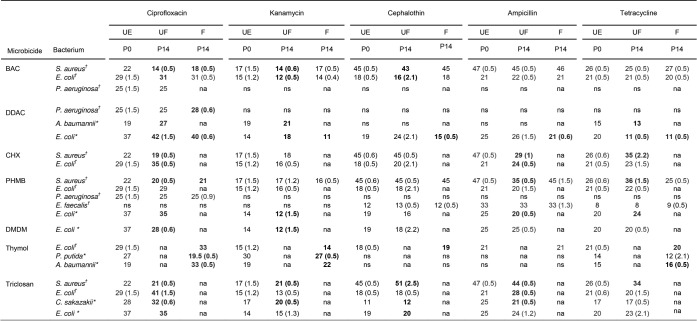TABLE 1.
Antibiotic susceptibility of bacterial isolates that showed a ≥4-fold decrease in microbicide/formulation susceptibility following exposure to microbicides in simple aqueous solution or formulated with surfactants and sequestrantsa
Data show growth inhibition zones (in millimeters) representative of antibiotic susceptibility before passage (P0) and after 14 passages (P14) in the presence of a microbicide/formulation. Antibiotic zones of inhibition were determined before antimicrobial exposure (unexposed [UE]) and after antimicrobial exposure to both unformulated (UF) microbicides (i.e., microbicides in a simple aqueous solution) and formulated (F) microbicides (i.e., microbicides with surfactants and sequestrants). †, nondrain isolates; *, drain isolates. Statistically significant changes are in bold text (P < 0.05). Bacteria that did not undergo a ≥4-fold change in MBC were not assessed for changes in antibiotic susceptibility. Where data varied between biological replicates, standard deviations are given in parentheses (n = 6). Combinations of a bacterium and an antibiotic for which BSAC breakpoints are available are indicated in blue text. According to these data, no susceptible bacterium became antibiotic resistant following microbicide adaptation. na, not applicable (i.e., the bacterium did not exhibit a ≥4-fold decrease in microbicide susceptibility following previous exposure); ns, nonsusceptible; BAC, benzalkonium chloride; DDAC, didecyldimethyl ammonium chloride; CHX, chlorhexidine digluconate; PHMB, polyhexamethylene biguanide; DMDM (hydantoin), 1,3-dimethylol-5,5-dimethylhydantoin.

